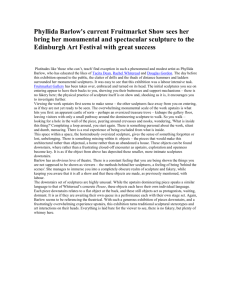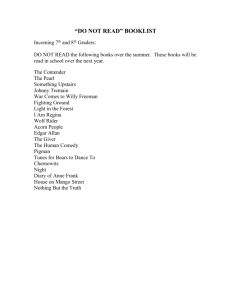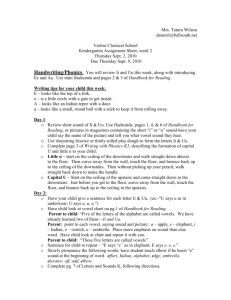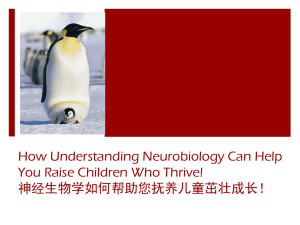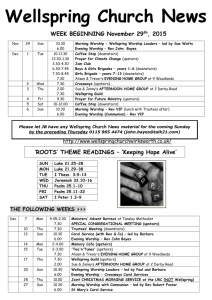Lesson 3 - Schools for Hope
advertisement
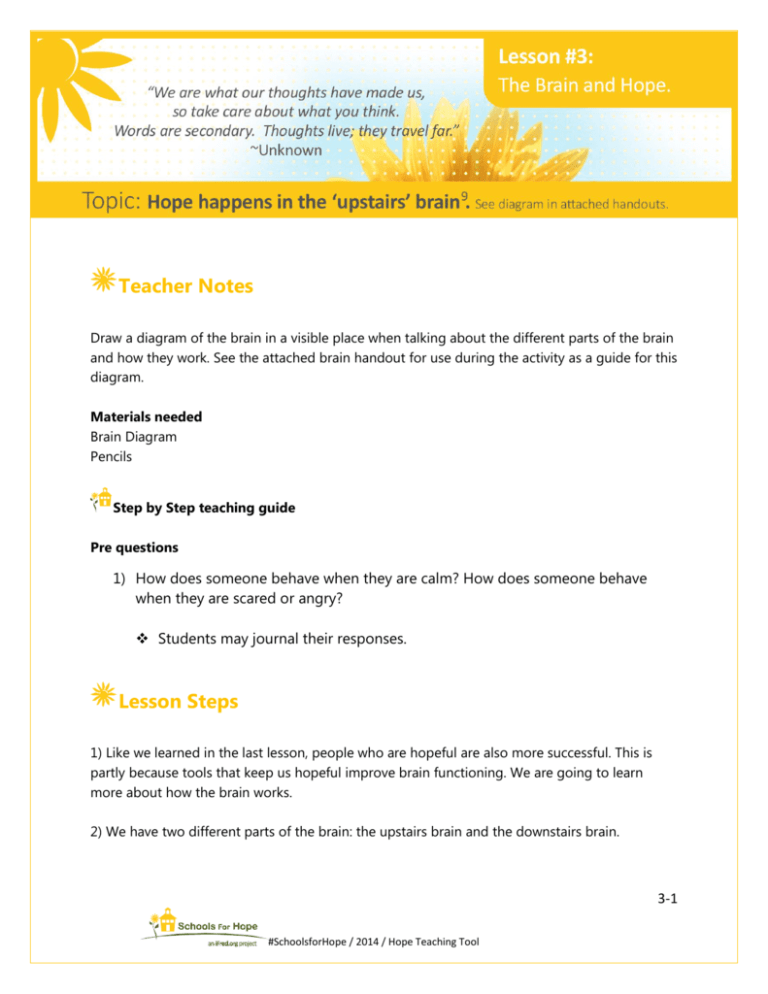
Chapter 3 Teacher Notes Draw a diagram of the brain in a visible place when talking about the different parts of the brain and how they work. See the attached brain handout for use during the activity as a guide for this diagram. Materials needed Brain Diagram Pencils Step by Step teaching guide Pre questions 1) How does someone behave when they are calm? How does someone behave when they are scared or angry? Students may journal their responses. Lesson Steps 1) Like we learned in the last lesson, people who are hopeful are also more successful. This is partly because tools that keep us hopeful improve brain functioning. We are going to learn more about how the brain works. 2) We have two different parts of the brain: the upstairs brain and the downstairs brain. 3-1 #SchoolsforHope / 2014 / Hope Teaching Tool 3) The upstairs brain controls more complicated actions and emotions like good decision making, self-understanding, and empathy. We use our upstairs brain to learn new things and when we feel hope. 4) The downstairs brain controls our survival instincts. In our downstairs brain, we feel strong emotions like anger and fear. Have you ever heard of fight or flight? Fight or flight is our body’s reaction to danger or a threat. The reaction of fight or flight is our body’s way to protect us from danger and it is controlled by our downstairs brain. It can be a great tool our body has to help us if we are in trouble. For example, if a lion were going to attack a zebra. The zebra must act quickly to fight the lion, or it may flee as quickly as possible to escape the danger. The zebra cannot spend much time thinking about what to do. It must just react to survive. Inside the downstairs brain there is something called the amygdala. This is an almond shaped part of the brain that is very powerful. The amygdala can take control of our whole body if it senses a dangerous situation. It does this by going upstairs and knocking on the upstairs brain’s door, and letting the upstairs brain know that the downstairs brain suspects danger and is about to react. When the almond reacts, we go into fight or flight mode. When the amygdala almond and downstairs brain take over, our upstairs brain shuts down completely. Our body shifts into instinct mode. After the amygdala almond decides the fear or anger is over, we are often exhausted and it’s hard to focus or pay attention. This means that if we are very angry, upset, scared, or frustrated, it can be really difficult to learn and retain information. It’s also hard to make good choices and it is challenging to see our hope. 5) In order to have hope, we need to stay in our upstairs brain rather than letting our downstairs brain take over. The good news is that there are tools we can use to calm down our downstairs brain. These tools will help us cultivate hope inside of ourselves and be better learners, friends, family members, and successful in the future. We will be ending our lesson today by practicing one of the ways we can calm our fight or flight response. It is a deep breathing exercise. 3-2 #SchoolsforHope / 2014 / Hope Teaching Tool 1) Can you remember times where you were angry, upset or frustrated and it seemed as if you couldn’t control how you acted? (Teacher prompt: by learning hope skills, we will figure out some skills we can use when this happens to us) 2) When was a time when you were able to really focus on something and remember what you learned? Do you remember what you did before that experience that may have primed your brain? Activity How are you feeling? Distress Assessment Scale1: The following tool is provided to help students identify their emotions and stress level. Distress is any emotion that you do not want such as fear, anger, sadness, frustration... 1.) Have each student rate how they are feeling on a scale of 0-10. 0 is not feeling any: fear, anger, sadness, and frustration 10 is feeling intense feelings of: fear, anger, sadness, and frustration When our distress level reaches a 7 or higher, we tend to not think clearly or act in ways that are consistent with our true selves. Students may use this tool anytime to connect with how they are feeling. When our distress reaches high numbers, this may be an indicator that self-regulation techniques would be helpful. We will be covering some of these exercises in Lesson 4 How to Create a Hopeful Mind. One way we can calm our mind and body is by deep breathing. Deep Breathing Exercise: When you take a deep breath, it calms your nervous system and your downstairs brain. Anytime you feel angry, overwhelmed or stressed, taking some deep breaths can help you calm down. Even if you can’t control your reactions at the time because your downstairs brain is in charge, you can remember to breathe deeply. This will help you get back into your upstairs brain. Let’s practice. (Teacher Prompt: demonstrate deep breathing and then ask students to join you. Inhale really deep breaths and exhale all of the air so that the exhale is audible.) 2.) What do you think? Do you feel any different after some deep breaths? Additional Teaching Tools for Lesson 3 1 Scale provided by Dr. Elizabeth Lombardo 3-3 #SchoolsforHope / 2014 / Hope Teaching Tool *The following list of stories and activities are recommended to enhance student learning, experience, and to encourage and promote further discussions related to each lesson’s content. Please choose what fits best for you, your students, and classroom environment. You may locate the resources listed below from the provided book Chicken Soup for the Soul in the Classroom. Stories p. 99 Did the Earth Move for You? (may also be used with Lesson 4 How to Create a Hopeful Mind) Activities p. 325 Good Boy/Bad Boy Kinesiology Demo p. 331 Inner Smile Visualization 3-4 #SchoolsforHope / 2014 / Hope Teaching Tool Upstairs Brain--------> Downstairs Brain---------------------------------------> Downstairs Brain--------------------------------------------------------------> <--------Downstairs Brain Downstairs Brain: Includes the limbic region and brainstem. It is the more primitive part of the brain and is responsible for: Basic functions such as breathing, blinking, and heart rate Fight or Flight Reaction (Amygdala) Strong emotions such as anger or fear Upstairs Brain: Includes the Cerebral cortex. This is where thinking, imagining, and learning occurs. This part of the brain is responsible for the development of: Sound decision making and planning Control over emotions and body Self-understanding Empathy Adapted from Siegel, D.J., & Bryson, T.P. (2011). The whole-brain child: Twelve revolutionary strategies to nurture your child’s developing mind. New York: Random House. New Directions. Integrating the Upstairs and Downstairs Brain: Teaching how to make good decisions in high-emotion situations. http://www.newdirections.mb.ca/services/traumaresources/11%20-%20Upstairs%20downstairs%20brain%20%20teaching%20how.pdf Diagram. (2014) http://www.rediscoveringancestralwisdom.com/wp-content/uploads/2014/08/parts-of-the-brainhippocampus.jpg #SchoolsforHope / 2014 / Hope Teaching Tool
